The Black Cauldron and the Seven Standards of Disney
The Black Cauldron is one of the few Disney Animated films that is highly criticized and widely disliked by a wide variety of people. Released in 1985, The Black Cauldron was the last of the movies within Disney’s ‘Rock-bottom age.’ In fact, because of Disney’s poor sales at the time, The Black Cauldron was responsible for the near-meltdown and death of Disney animation. It is a pity too because the Black Cauldron attempted to do what Sleeping Beauty failed to do, revive the Disney Princess franchise. This is apparent because the very existence of a Princess in the land of Prydain, the setting of our sad tale, means that Disney once again attempted to return to its roots.
The only reason that things are different today is because the Disney Princess franchise is back and strong due to the efforts of The Little Mermaid, which revived the Disney Princess franchise. Both The Black Cauldron and Sleeping Beauty failed with their audiences because both movies had standards which they failed to meet. The Disney Princess franchise started with Snow White. Snow White was a low but good starting point. The Princess was rescued by a Prince. Simple. Cinderella came next and blew it out of the water. It surpassed Snow White and more, Cinderella actually had a character. She was a maid who aspired for something more. She had companions, a developed villain, and her own personal deus ex machina to go with her. She held on to her faith and pulled through despite all odds and family against her.
The Black Cauldron met few but not all of those standards. As a movie, The Black Cauldron was indeed a good piece of work. However, once the audience starts watching it as a Disney movie with standards to meet, (which is clearly what it was going for) it fails and is therefore unknown, and among those who do know it, almost universally disliked. In order to understand where a Disney movie fails, it is best to look at the standards at which a Disney movie is judged. What are those standards? The tale’s origin and storyline, the Princess itself, the romance, the villain, its musical numbers, the setting, and the side characters. Based on those standards and comparing it to several movies before and after it was released, (particularly Sleeping Beauty which also failed at the Box Office) the Black Cauldron does not meet the seven standards as well as other Disney movies do.
Disney Origin and Storyline
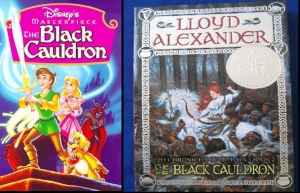
All Disney movies, whether they are adapted from fairy tales or not have their own original take on their material. Sleeping Beauty was originally a fairy tale. In Charles Perrault’s version, an evil, jealous fairy named Caraboss curses the nameless child to die on her sixteenth birthday. A good fairy pops up and changes it to a simple sleep until she awakens by true-love’s kiss. One hundred years after she falls asleep, a Prince travels to the land where time stands still and sexually abuses her lifeless body. She births twins and wakes up, marries her abuser and lives in a forest where an ogress demands for the Princess and her children to be cooked. The King arrives to stop this and the Ogress commits suicide. The evil fairy is never heard from again and everyone lives happily ever after.
Disney’s Sleeping Beauty opens with a narrative as if being read from a book. The basic storyline is introduced and the evil fairy who was renamed Maleficent curses the baby. Instead of abusing her, the Prince meets Aurora (who is named after one of her children in the original fairy tale) by chance in the woods and dances in a very iconic scene. There are three fairies instead of one and they are the central protagonists: Flora, Fauna and Merrywheather. They are focused on more than Aurora herself. They raise Aurora for sixteen years, well hidden from Maleficent and her spies until she is found and cursed. The entire Kingdom is put to sleep, and Prince Phillip is captured. The fairies rescue him and warn him of dangers he ‘alone would have to face,’ (guess the Blue Fairy from Pinocchio isn’t the only liar.) They give him a sword and shield, save him from rocks, arrows, give his horse a boost across a deep chasm, and enchant the sword to destroy all evil.
The Black Cauldron was originally a book series called The Chronicles of Prydain authored by Lloyd Alexander. The film is split into five different books, each of which is noted to be much deeper and more significant than the film itself. Disney took the title of the second book and gave it to the film along with the basic plot of stopping a horde of undead soldiers from rising. However, the villain who attempts to do this is not from the second book but from the first and a minor villain in the wider storyline of the books. It can be argued that instead of attempting a single story like Sleeping Beauty did, the film attempted two of the five stories and subsequently ruined it.
Unlike Disney’s Sleeping Beauty, The Black Cauldron did not have its own original take on the source material. It took elements from the first two books and combined them. The Horned King, a minor villain from Book of Three, is made the main villain in the film as he chases the Black Cauldron itself to raise an army of Deathless Warriors known as Cauldron-born, both elements being from the second book, The Black Cauldron. The characters themselves are from the books, which is less than what we can say for Sleeping Beauty’s characters. Taren is still an assistant Pig keeper and still wants to be a hero, and his companions, Gurgi, Fflewddur, Hen Wen and Eilonwy, are the same.
When Taren’s oracular pig, Hen Wen, reveals that the Horned King is after the Black Cauldron itself to raise the dead, knowing that Hen Wen can reveal its location, they are sent off to safety by Master Dallben. Hen Wen is captured by the Horned King’s minions and Taren attempts to rescue him, getting himself captured in the process. In the castle, he meets captives Princess Eilonwy and Fflewddur the bard who aid him in his escape. The pig is saved and the group, once reunited with the cowardly and hungry Gurgi, meets the Fair Folk. The Fair Folk transport them to Morva where the Cauldron is said to be. Meanwhile, Hen Wen is sent back home. In Morva, they trade the enchanted sword they found in the castle for the cauldron which is subsequently captured again. Gurgi sacrifices himself to destroy all evil, the witches trade Gurgi’s life for the Cauldron, Taren kisses Eilonwy and they all skip happily into the distance.
Though adapted from fairy tales or books, most Disney movies take liberties with how they tell the stories. When The Black Cauldron was made, they took fewer liberties. As said before, they jumbled some elements together from different books and this may have given the movie a rather chaotic feel to it. In this sense, Sleeping Beauty was simple and smooth whereas The Black Cauldron was disappointing. Nonetheless, The Black Cauldron is not without its memorable scenes. Its most Disney-like scene was arguably the bargain with the witches.
Disney Princess
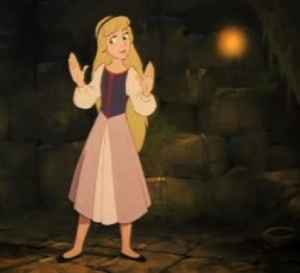
Due to Aurora’s limited appearances, Princess Eilonwy should not have trouble outclassing Aurora. Unfortunately, she does. Nothing is known of Eilonwy’s parentage in the film. All we have are the books which cannot be taken into account because of the liberties Disney tends to take with source materials. All we know about Black Cauldron’s Princess is that she has a glowing bauble which leads them out of the Horned King’s castle. It is a pity because just seeing her and her relationship with Taren begs for more development. All we get is an abrupt kiss at the end that nobody would have seen coming. The romance seemed only half-done with little development leading up to it. Where Cinderella had her faith and dreams, her persistence and animalistic companions, Eilonwy is far from the standards even Aurora set before her and Aurora barely appears in her movie.
In Sleeping Beauty, Aurora is a high-born Princess gifted by three fairies song, beauty and life. As such, she grows to have a lovely voice, untold beauty, and the ability to live through the spindle, provided she is awakened by true-love’s kiss. Meanwhile, Aurora is taken by the fairies to live deep in the forest, in the glade where she is raised for sixteen years. There, she meets someone who she believes is a passerby and falls in love, not knowing that he is her destined Prince who long ago was arranged to marry her. Unfortunately, Aurora gets very little screen time in the movie. In fact, only a quarter of the movie is dedicated to her despite the title being named for her. True to the name Sleeping Beauty, she is never heard from again. Even in the end, she is silent. Disney failed with her and paid the price for thirty years.
This is a shame because each and every Princess Disney had produced, even up till now has something special and unique, even the first three. Snow White is the youngest Disney Princess, Cinderella is far more faithful and hopeful than Snow White, and Aurora has less screen time and thus less development than any other Disney Princess. Skip to the Disney renaissance and even their races are different. Ariel is Disney’s mermaid, Belle is French and the first Princess to save the Prince at the climax and the only Princess whose movie makes a point of that, Jasmine is Arab and has more adventures than any other since she is present in three movies and an animated series, Pocahontas is Native American Princess and the only one to be denied her love-interest, and Mulan is Chinese and the only one to carry a weapon. Then we skip to twenty-first century Princesses and we see that Tiana is the only Disney princess to actively work towards her dream (owning a restaurant,) Rapunzel is Disney’s most proactive Princess with such a wide range of talents to appeal to almost anyone, and Merida is the only Disney Princess to reject romance of any kind.
When one looks at how unique they all are, and looks at Eilonwy in comparison, she looks surprisingly bland. What is unique about her apart from the fact that she has a glowing bauble? She is probably the only Disney Princess to accidentally kiss her love interest.
Disney Romance
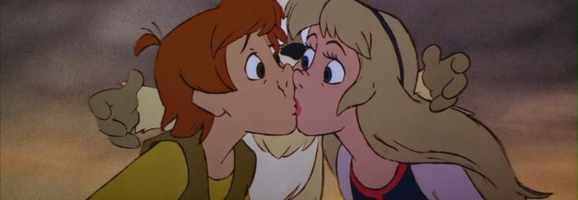
Disney romance is an incredibly important standard for movies like Black Cauldron and Sleeping Beauty to meet. Disney romance is almost a given but not necessarily a must (look at Emperor’s New Groove and Pinocchio, let alone Peter Pan.) Of course, the loveless movies did not attempt to meet that standard like Black Cauldron clearly tried to do. Romantic relationships are typically displayed by a musical duet or at least one iconic scene with the two together. A poorly done romance does not look good in a Disney movie due to its excellent record in this genre.
Aurora and Prince Phillip in Sleeping Beauty had a relationship arguably more developed than Cinderella and the nameless Prince Charming. Snow White barely developed its romantic climax. It was only placed as a given that it would happen in the end. Cinderella just wanted to get out of the manor she worked and lived in and she happened to fall in love with Prince Charming on the way. Aurora and Prince Phillip had their relationship being built towards by the narrative itself. It started as an engagement, but through a chance meeting in the woods they fell in love without knowing the other was their betrothed and had their widely loved Once upon a Dream sequence.
The Black Cauldron had a chance with the romance between Taren and Eilonwy. Unfortunately, that relationship was so abrupt it meant nothing. The movie could have deleted the kissing scene and nothing would have changed but we cannot simply act like it did not happen because the fact of the matter is, it did happen. Kisses in Disney mean everything and it happened. Even onscreen, the kiss was so awkward and practically forced that one might cringe just watching it. For such an important standard in a company which prides itself on its romantic storylines, The Black Cauldron fails at this poorly executed attempt.
Disney Villain
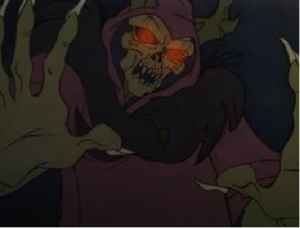
In the original Chronicles of Prydain series, the Horned King was only a minor villain appearing in the first book. He never tried raising Cauldron-born Deathless warriors. That is for another villain to do in the second book. In the film, the Horned King is the typical overlord with horns, a skeletal face, and a high, cold voice to impress even Lord Voldemort. The Horned King is mostly silent thus adding to his threatening demeanor.
Meanwhile, Maleficent surpasses her original counterpart Caraboss. After the nameless Princess is awakened, Caraboss is never heard from again. She is defeated but she is not seen. Maleficent is far more theatrical than the Horned King and far more powerful than Caraboss with her ability to create destructive purple lightning bolts, curse sentient beings into performing acts in the future (thus altering destiny itself,) the ability to conjure dangerously sharp thorns, appear and disappear at will, and transform into a will-o-the-wisp. Her dragon form only makes things worst. Till now, Maleficent may be the most powerful villain Disney ever introduced with only Jafar able to stand a possible chance.
Where the Horned King has as much development in either material, Maleficent surpasses her original form and has the ability to surpass even that with her dragon transformation. When she is beaten, she fights back. She tries very hard to stop Aurora’s curse from being broken. The Horned King only sent minions around and when he got involved directly, he was taken care of very quickly. It was as simple as sending Gurgi into the Cauldron and as usual, Gurgi is resurrected in the end so the sacrifice is minimal. Because of how quickly the Horned King is defeated, Maleficent takes the cake in this one.
Disney Music
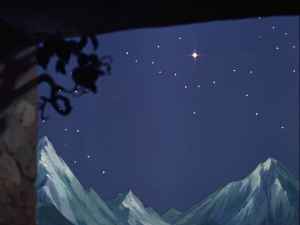
In terms of Disney music, musical numbers usually go to the protagonist, the villain, and some side characters. The very first Disney movie Snow White opened with one of Disney’s most beloved classic songs, I’m Wishing quickly followed by One Song. If the Prince’s voice was not enough to dazzle the audience, Snow White herself sang the famous Someday My Prince Will Come and even the dwarves had their own musical numbers Hi-ho and Silly Song. Even Disney movies that do not have a musical focus like Pinocchio have their own famous pieces. When You Wish Upon a Star comes to mind.
If these pieces were not enough, Cinderella, the movie we established set the standards high for Sleeping Beauty and Black Cauldron, also has major songs. Bibbidy-bobbity Boo, A Dream is a Wish, and This is Love all come to mind. The mice even have their song as they help Cinderella achieve her dream. Sleeping Beauty could have gone further but did not. The Black Cauldron could have gone further but it did not because the characters did not seem the sort to break into song.
This is where the two movies are weak in originality. Black Cauldron only has a musical background track. While it can be argued that alone should be enough, for a Disney movie, it is not. Sleeping Beauty’s track is purely from the famous artist Tchaikovsky. The only song in the movie, Once Upon a Dream was adapted from one of Tchaikovsky’s pieces whereas Black Cauldron only has background tracks. This results in Sleeping Beauty overshadowing it. It is not dishonor on Black Cauldron, as a movie because films almost always have wordless tracks in the background. As a Disney movie, however, wordless tracks and lack of a memorable song is a mistake.
Sleeping Beauty made a mistake in music too. Compared to all other Disney movies where most of their pieces are original, Sleeping Beauty is pure Tchaikovsky. Maleficent did not have a musical number and considering her theatricality, one wonders why. Even the fairies lack a number which could be a pity because the last fairy Disney had, the Fairy Godmother had her musical number. The Black Cauldron has no pieces whatsoever worthy of mention. The Horned King might have broken into song but that admittedly would have ruined his demeanor. Perhaps the villain was too dark to allow for a number.
Disney Settings
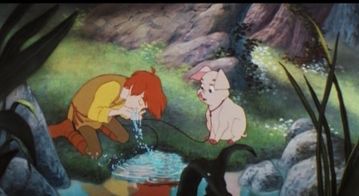
Springing from the concept of storyline, the settings of Disney movies are especially important. Each Disney movie, particularly the classics, hold at least one major setting that the movie is known for such as Agrabah, the glade in Sleeping Beauty and the swamp in Princess and the Frog. This wide variety of smaller settings gives the audience the feel of a more open world. Of course, there is the danger of overdoing it. If the audience is given so many settings at once in a movie that is typically only sixty to ninety minutes, the movie develops a chaotic feel. Choosing how many places to introduce and what they look like is an art.
In Sleeping Beauty we had King Stefan’s Kingdom at the beginning, then we were introduced to the Glade where the fairies raise Aurora, we travel back to the Kingdom and off to the Forbidden Mountains. It was very simplistic and each and every setting was constracted and drawn carefully. For such a well-regarded Disney movie, Sleeping Beauty had very few settings to work with, and despite Aurora’s lack of sufficient screen time, all of them were richly done. Its poor showing only made it a bigger pity that it all went down the drain after the hard work that went into it. It was not till years later, after the Little Mermaid saved Disney Animation that Sleeping Beauty got its appreciation.
In Black Cauldron, so many settings are given, one wonders just where this war is even taking place. Taren starts at the cottage, takes Hen Wen through the Forbidden Forest, ends up in the Horned King’s castle, they disappear into the Fair Folk’s home, get transported to Morva Marshes, and then revisit old places. The only setting we see a lot of is the castle, the Fair Folk’s home is barely seen, only the Morva Marshes are given real development (think witches bargain here) and who knows why the Forbidden forest is forbidden in the first place. For all the settings we see, not one hint of the ongoing war against the Horned King is shown. The war could be cut out and no changes would be made to the wider plotline. This suggests disagreement between setting and plotline, which is a big mistake in Disney movies.
Disney Side-characters
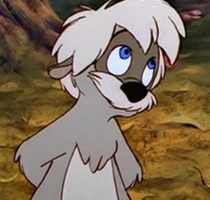
One very important aspect of Disney and a very important standard are the side-characters introduced. These characters are typically loved, iconic and fantastically done. After movies like Pinocchio which introduced Jiminy Cricket, one of Disney’s most beloved mascots, the Fairy Godmother in Cinderella and the Genie or Abou from Aladdin. Even tiny little Tinker Bell from Peter Pan is so beloved, she has been given what no Disney side character has ever been given before: Her own movie series. Even the later movies like Tangled and Frozen introduced to us Pascal and Elsa (even Olaf) respectively.
Sleeping Beauty’s three good fairies Flora, Fauna and Merryweather have been given loads of press only made more significant when they play as major supporting characters in the new series Sofia the First. These fairies did not receive such press for a long time, so Sleeping Beauty lacked in that department for years. Because Aurora was barely seen, the love for her which should have hit an all-time high and beating everyone’s love for Cinderella and her mice, was minimal.
The Black Cauldron had no such thing. Its only lovable character was Gurgi and he reminds us too much of Smeagol from Lord of the Rings to be taken too seriously. His reluctance to do anything worthwhile save for the end only made it worst. Fflewddur, the Bard might have been widely loved but did not receive development for him to be loved. The question of how he ended up with Eilonwy in the first place remains to be answered so he almost appears as just an unlikely companion in the larger quest. Hen Wen is a lovable character and had his powers been developed and explained a little bit instead of making the magical pig a given, she might’ve worked.
Conclusion
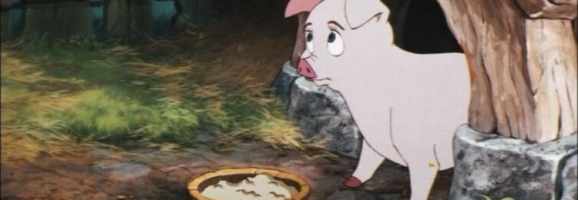
There are seven significant standards to a Disney movie, particularly a movie like Black Cauldron and Sleeping Beauty. Both failed at some but the Black Cauldron failed with almost all of them. While the Horned King was a fine villain on the outside, even when they take free liberties with the original material, the film still handled the material wrongly, thus wrecking not only the origin standard but the storyline standard as well, they failed miserably with their Princess, ruined what could’ve been a finely executed romantic subplot, its characters were so one-sided with very little to remember and love about them, its setting was stretched too far to start raising questions relating to the storyline itself, and its music was almost nonexistent.
Why did Sleeping Beauty grow from being disliked to being loved? Disney standards were not established yet when Sleeping Beauty was released. It was not until much later, in the 1980’s with the Little Mermaid when Disney made clear what those standards were. Each and every Disney movie of that type stuck with those standards. Perhaps some fell short but none failed as badly as The Black Cauldron. Even Disney movies that lacked an established Disney Princess still had a heroine major enough to be one, still had a memorable romantic subplot (never forget Simba and Nala) and still kept some lovable character we remember to this day (think Archimedes Porter from Tarzan.)
Many Disney movies lack a Princess altogether. One thinks of Pinocchio and how it lacked its Princess and a romantic subplot and they are right to think so. Because of its type, Disney neither needed those standards nor were they even trying to live up to them. Where two standards were ignored, five others were exceeded. Its music is superb (yes, that one piece is enough), its characters are long remembered (Jiminy Cricket will never be forgotten), its settings are almost terrifying, (think Pleasure Island here) its origin is widely regarded, its storyline is straightforward and true to itself and its original material, and its villains are many let alone real (think Coachman.) The Black Cauldron not only attempted to meet the standards, it failed and it failed with more than half of them.
The Black Cauldron is not a bad movie. One may still derive enjoyment from it and as a stand-alone movie it is truly a work of art. However, the second one watches it as a Disney movie with standards to live up to, once we remind ourselves that it is trying to live up to them, the striking realization comes that it failed. As a movie, it is fine. As a Disney movie, it is a failure. At least for now. Like all companies, Disney evolves. If ever new standards are expected of Disney movies and the Black Cauldron happens to meet them, it may well be that, one day, it will be as widely regarded as Sleeping Beauty is now, (another movie that failed for its time.) The Black Cauldron is not a bad movie and certainly worth watching, just not a good Disney movie.
What do you think? Leave a comment.
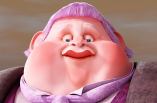

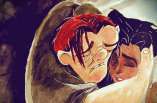








I liked the part where Flamm’s in prison and he’s like He-LLLLLP! That made me laugh. I enjoyed it even though it could’ve been better. This film could’ve been way better, sure, but I still enjoyed it for what good qualities it had.
Lion King was a proud moment in disney history.
Lion King is my personal favorite 🙂
This is not one of my favourite disney movies but I don’t hate it like most other people. I thought the parts with the dragon, that beam of light shooting out of the black cauldron, the green stuff coming out the cauldron and the death of the Horned King looked pretty cool and my favourite line the Horned King says is “Get up you fools! Kill!”
I adore this film & it was one of the 1st Disney movies I ever saw. Seeing bits of it again after so long, I think it could have been better. Maybe someday a GOOD studio will remake it. Tim Burton worked on this. He’s also known for being an artist in The Fox & The Hound.
Tim Burton worked on this movie? And Fox and the Hound? Well, you learn something new every day.
Please, no! The reputation of the series is still recovering from the cartoon, which most of the world seems to have done its best to forget about. No producer will ever make a faithful adaptation of the books.
It response to SpectreWriter’s reply, I must concede that The Fox and the Hound is an example of how it is possible to take a terrible story (ingenious book, lots of research & effort, yet very little substance in terms of messages) and make it into a half-decent cartoon.
I remember this film…
Never saw this when I was a kid and watched it recently cos I’m so sick and tired of all the obnoxious CGI animated movies we’ve had to endure over the past 15 or so years. Was pleasantly surprised by this movie. Nicely animated and with a lovely dark atmosphere. Not exactly the most original story but I enjoyed it greatly.
I haven’t seen this in years but I remember loving it, which is strange because I never really liked Disney as a kid.
It’s not strange at all. The film failed as a Disney movie, in my opinion because it does not meet it usual standards. So, someone loving it but disliking Disney makes sense.
I remember seeing clips of this film on the Wonderful World Of Disney as a child and at the time, I wondered why it wasn’t available on video like Disney’s other films. In my mind, it became almost mythical because it was the one Disney cartoon I had never seen. When it was finally released on video in 1998, I was 15 and had read the novels – and loved them – in the meantime.
While it is a poor representation of the novels’ story, I’ve always loved it purely as a film and have always felt that it deserves more respect. If you happen to have a projector (or even if you don’t), this is the kind of film that makes it worth owning one so you can see it on the grand scale it was intended for.
I wish disney would remake this film, but in live action or something.
I enjoyed reading your analysis on the characterization of the Disney princesses and their unique abilities compared to Eilonwy.
Great job identifying Disney’s standards and analyzing how The Black Cauldron measures up. Sometimes I forget how important music is to character development in Disney movies, and this might be a big part of the disappointment in this movie.
I like the historical context you gave us of how The Black Cauldron was a movie that failed to revive the Disney classics (those that set the standard). I also like how you remind us how EVIL and crazy powerful Maleficent was in Sleeping Beauty, despite her recent portrayal.
I read the first book in this series a looong time ago, and remember the movie was a bit of a let down…Still, I was comparing it to the book. You say it is a Disney failure, and I say it was a book adaptation failure. I wonder how I would like it now as simply a form of entertainment.
Very interesting article on a not so famous and not so loved Disney, but you’ve managed to establish a well-judged criticism and show the positive aspects of the film too. Thanks!
And yes Tim Burton worked on this, and when everyone considered it a failure, it emphasised his contempt at Disney.. He hated working there apparently.
Interesting. And that is very surprising because Burton made Nightmare Before Christmas as well as Frankenweenie with Disney and they really worked well together there.
Ah, well, maybe he grew out of it. Things did change from the 80’s to the 90’s and honestly after the travesty at the Box Office, perhaps Disney was punished enough.
I really enjoyed reading your article! I had no idea that the Black Cauldron was pulled from a book series, and your criticism was insightful and interesting. I remember watching this movie for the first time and being terrified of/grossed out by the Horned King and also wondering how in the world a pig had such a power – still kind of confused by that haha
You’ve touched on every reason why I wouldn’t watch this movie ever after the first time we put in the VHS as a child! Well that and I think it gave me nightmares. The only redeemable aspect that stands out in my head is Gurgi, and one fuzzy Gollum (i laughed at your pointing that out, bravo) does not a quality film make. Thanks for this thoughtful analysis!
I really want to watch this, but it’s hard to find. I just finished the first two books of the series.
I played the game on the apple computers when it came out. Really hard game, but mainly due to the controls.
One of my fav Movie!! Thanx for the great analyses!
The Black Cauldron: A true tragedy in the history of Disney, not only a crud production history (thanks to the big K who thinks editing and re-writing it would make it better for kids), but failing in the box office and critics as well. Despite being a little talkative and featuring some of the usual Richard Rich traits, I have a soft spot for the movie, and it sort of represents the end of an era for Disney before becoming heartless idiots (not how my Mum and Dad use to see them).
The Black Cauldron is awesome!
this is one of the best Disney films of all time, who truly cares what other people think…
I really enjoy this movie. Not for story or characters. I enjoy it for the setting. The music, and animation. The Horned King is enough to give this a watch for me if you like creepy things. But yes this movie had it´s problem with a 11 years production and that restart you mentioned. So just a hard work for nothing movie sadly. But I enjoy what I can get of it.
Interesting! I always figured Black Cauldon wasn’t successful because it was so different from the other fairy tail films, but I guess I wasn’t really paying attention. Nice article!
Do you want Disney to release The Black Cauldron fully uncut on Blu-Ray? Then like and share my Facebook page!
facebook.com/TheBlackCauldronPetition
i love this movie *^* but i think it would have been way better if it had some songs(Taran and Eilonwy singing a duet,Elionwy singing her own song,and The Horned King singing a really dark and creepy song) and Taran and Eilonwy having more romance. and they should not have deleted the gruesome scenes from the movie ;^;
(like this page if u want Disney to release the movie uncut,with the scary deleted scenes put back in https://www.facebook.com/TheBlackCauldronPetition?ref=profile )
You know, I’ve heard a lot about the hate that some people have for The Black Cauldron, and while it hasn’t ever been my favorite movie, I’ve never quite understood the basis for hate. With this more objective analysis, as well as comparison with established standards for Disney, I can definitely see the perspective easier. As mentioned, of course, the movie in and of itself is still fine, but it does not uphold the standards that people expect if they have ‘Disney’ in mind.
Thank you so much for your wonderful analysis of both Sleeping Beauty and The Black Cauldron!
This is one of the worst-written, most poorly-researched articles that I have ever read. First of all, the Disney Princess franchise didn’t exist until the late 1990s. Neither Sleeping Beauty nor The Black Cauldron were meant to “revive” it, because it didn’t exist yet. Secondly, Sleeping Beauty gained popularity through its home video releases, not because it suddenly began living up to certain standards. Speaking of, how could The Black Cauldron have failed to catch on due to not living up to Disney standards, when you claim that the Disney standard wasn’t established at the time? You also say that The Black Cauldron is hated specifically because it’s viewed as a Disney movie, but doesn’t utilize a lot of Disney conventions. That reasoning is especially faulty when you consider movies like Toy Story, Wreck-It Ralph, Lilo & Stitch, and The Emperor’s New Groove, which all largely did their own thing instead of relying on Disney conventions. With those films in mind, maybe The Black Cauldron being made by Disney has nothing to do with its bad reputation. Maybe it has everything to do with bad writing, annoying characters, a tacked-on romance, a boring villain, and a lack of character development. Because of that, the movie wasn’t profitable in theaters, it isn’t profitable on DVD, and it will never be profitable on any future formats. Do you know why? It’s not because people expect certain conventions from Disney, it’s because people expect quality from Disney. Otherwise, movies like Lilo & Stitch or Toy Story wouldn’t have been as successful as they were.
Toy story was all Pixar. Disney has **nothing** to do with it, so much so that in 2005 Michael Eisner created Circle 7 only to produce Toy Story 3 as an eff you to Pixar, their contract was over. In 2006 Eisner was out and Bob Iger became CEO. Iger bought Pixar and gave them the responsibility to pull Disney out of it’s hole… So much control that Ed Catmull closed Circle 7 down and ended production on Toy Story 3. Lots and lots and lots of lay-offs.
Lilo & Stitch had an excellent director, Chris Sanders. So great that Disney fired him during American Dog. Ed Catmull didn’t like his risky way of storytelling.
Toy Story and Lilo & Stitch still had Disney’s name on them. People viewing them at the time still would have viewed them as Disney movies, especially considering that Pixar wasn’t a household name when Toy Story was first released. My point still stands that The Black Cauldron being different from Disney’s usual fair was not the reason it failed.
I dislike both Disney and this movie. I mean, even if you haven’t read the book (and thereby know what you’re missing), exactly what does this movie have to offer? Its creepiness is scarcely in a class of its own, and its attempted statements about sacrifice really weren’t very poignant, not even by Disney’s standards. Besides, a number of important messages and details from both books were completely subtracted, in some cases creating plot holes that really can’t be rationalized. If this movie is part of your childhood, I am sorry. No matter what you were looking for, you could have found a better choice.
As far as Disney is concerned, I must say that I received some satisfaction in reading that, for once, one of their misleading adaptations of somebody else’s story blew up in their faces.
Seriously? Eilonwy set a standard that was then copied with nearly every Disney Princess since. She was the first to have more then a 1950’s dreamy, shadow-self personality, and she rescued “the prince” before Belle made it mainstream.
http://41.media.tumblr.com/c45127eea0a39d84804d331f5fd2d187/tumblr_ntmq91RGRs1tmyt1po2_1280.jpg
As for the music, Elmer Bernstein’s score was practically murdered by a last minute edit that removed nearly a 1/6 of the movie and had the editors running over time to try and make the new edit make sense. That’s why the music is so minimal.
As for source material, how many 3 year olds read HCA’s Little Mermaid before seeing the movie? Source material, while interesting to look at after the fact, should not be a factor when deciding whether it has the “it” factor or not. Frozen for example, is a great movie on it’s own, but compare it to the source material (again, HCA) and you want to snap the disc and never think of it again.
You mentioned that there seemed to be no proof of an on going war. How does the severe lack of people not constitute as proof of that? They’re either like Eilonwy or Fflewddur (captured) or dead, like everyone else seems to be, given that there are, what, 4 human characters for the entire movie?
The romance standard was not needed in this film as Eilonwy was only 12.
Gurgi is nothing like Smeagol, because a) (as you’re so fond of source material) Smeagol was not like that in the books, and b) Gurgi came first (speaking in terms of movies, of course) ergo, Smeagol is like Gurgi, not the other way round. Gurgi is actually more like a woodwose.
The Horned King (Books aside) is one of the scariest Disney bad guys. Maleficent went on her little rampage because she didn’t get invited to the royal party (stupid excuse, but one nonetheless). The Horned King, on the other hand is just freaking bad. Evil. Demonic. He does he death dealing because he wants to. No reason needed.
Eh… Eilonwy was actually not that bad as a Princess herself, but when compared to others, not to mention her bland characteristic, very little story as to where she comes from, there’s not much to say about her. Most Princesses have a setting to go with them, I don’t know where this girl comes from. My point with her is that she was god, but not done justice.
If we can explain this all by Disney cutting something out and then scrambling to help things make sense, it’s still bad. It means they didn’t know what they were doing while making it, and it ended up suffering because of it. If they originally meant to put music in it, but cut it out, that was a poor mistake on their part.
Usually, in terms of source material, I don’t give a pass or fail. Since Black Cauldron as a whole is a poor Disney movie, then it negated from its storyline standard, and that’s why it falls apart there. It just seems jumbled up and chaotic.
Also, if the romance standard isn’t needed, they should have never, ever added a forced kiss like that. If it’s not needed, don’t put it in. Cut it out and replace it with whatever you cut out before to make the movie sensical. That easy.
Personally this is my favourite Disney. The problem with Disney IS the standards and songs and I wholeheartedly disagree that reproducing a (commercially) successful formula should be advocated or applauded.
Criticizing the lack of background of characters in The BC is suggesting that the fuller portraits of idealised princesses of more acclaimed titles is more realistic/believable? I know that disney themselves probably reflected on where they failed (as you identified well with their traditions in this genre) however these are the aspects which I believe made the film a stand out from normal disney predictable crap. I enjoy not being told where a character came from and is going to and there is much more mystery that enshrouds this film and fun to be had imagining the past life of the bard or Dalben etc. Also Eionway is far more progressive as a female character than is sadly the norm.
Another thing is the issue of the source. I have read a few of the books and they are a bad patchwork of Tolkein and Welsh mythology, diluted for children. So there’s not much to work with however I believe the ominous background music, and various settings create an expansive and threatening world, far more interesting than most Disney films of this genre.
I think the obvious risks they took (genuinely scary villain and one of only two depictions of blood in their films at this time) are rewarded in how most people I speak to about this film recall it from childhood as something they were both scared and intrigued by, far more affecting than Cinderella.
It doesn’t tick the boxes of a disney film but this is to be celebrated not condemned. I admit it’s far from perfect but this is personally more preferable to a twee, well knit story with well defined aspects.
Using only instrumental music was a sign of how much Disney was in a Dark Age.